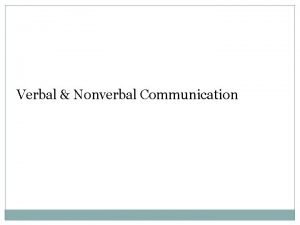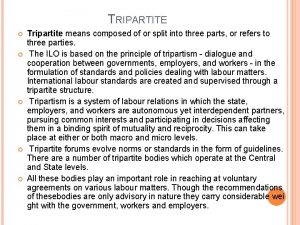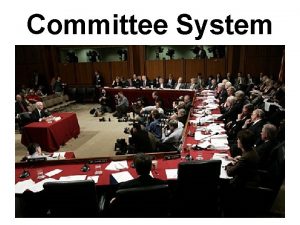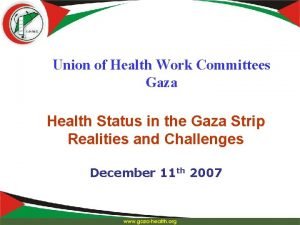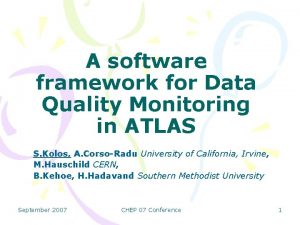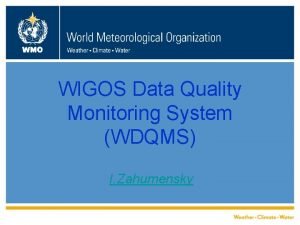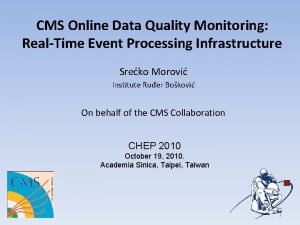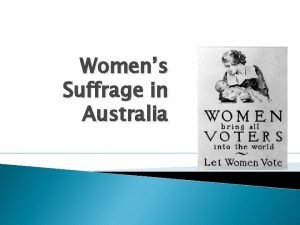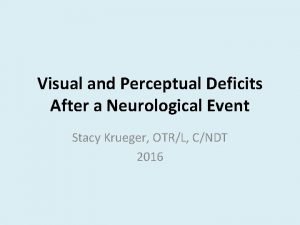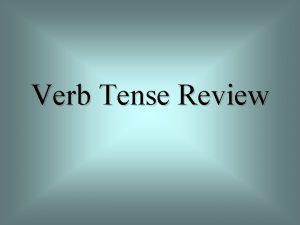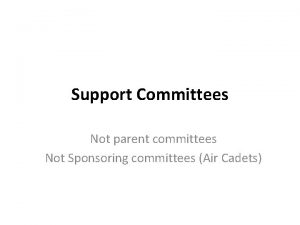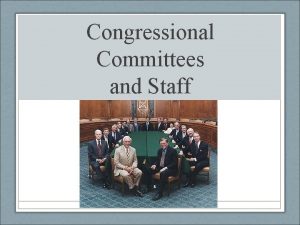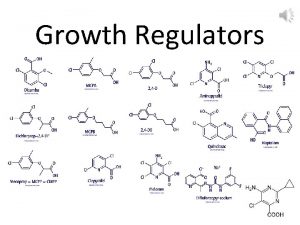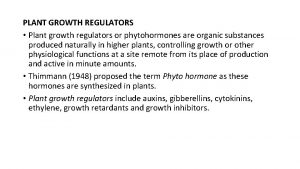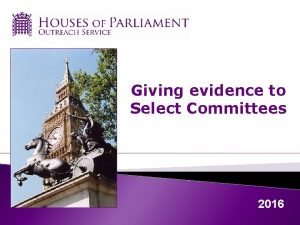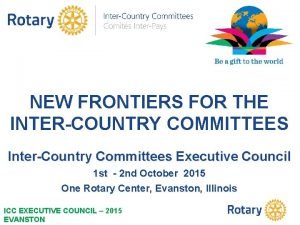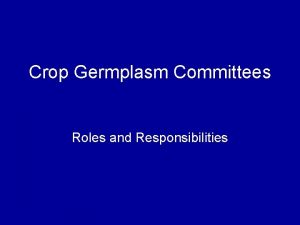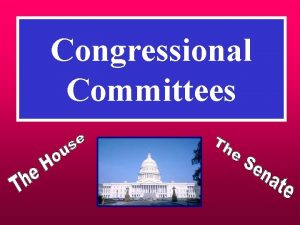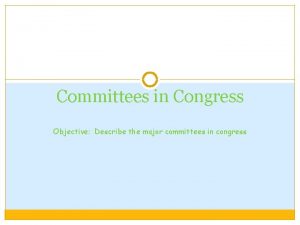DATA MONITORING COMMITTEES A Regulators Perspective Mary A



![GOOD CLINICAL PRACTICES [ICH E 6 5. 5. 2] The sponsor may consider establishing GOOD CLINICAL PRACTICES [ICH E 6 5. 5. 2] The sponsor may consider establishing](https://slidetodoc.com/presentation_image_h/2ba4ee863f735b26ba11f497a0a12aab/image-4.jpg)









































- Slides: 45

DATA MONITORING COMMITTEES: A Regulator’s Perspective Mary A. Foulkes, Ph. D. Office of Biostatistics and Epidemiology Center for Biologics Evaluation and Research FDA March 7, 2003 Medical Research Summit

SOME HISTORY • Little in regulations/guidance address data monitoring committees (DMCs) • Since the 60’s, mostly in governmentfunded trials (NIH, VA) • Increased use of DMCs over past decades • Many different models in use • HHS Office of Inspector General recommended in 1998 that FDA clarify appropriate role and procedures for DMCs

REGULATORY STATUS OF DMCs • One mention in U. S. regulations: required for emergency research studies in which informed consent requirement has been waived (21 CFR § 50. 24) • Mentioned in guidance documents developed by int’l committees for conduct of clinical trials • Draft guidance specifically on DMCs issued November 2001
![GOOD CLINICAL PRACTICES ICH E 6 5 5 2 The sponsor may consider establishing GOOD CLINICAL PRACTICES [ICH E 6 5. 5. 2] The sponsor may consider establishing](https://slidetodoc.com/presentation_image_h/2ba4ee863f735b26ba11f497a0a12aab/image-4.jpg)
GOOD CLINICAL PRACTICES [ICH E 6 5. 5. 2] The sponsor may consider establishing an independent data-monitoring committee (IDMC) to assess the progress of a clinical trial, including the safety data and the critical efficacy endpoints at intervals, and to recommend to the sponsor whether to continue, modify or stop a trial. The IDMC should have written operating procedures and maintain written records of all its meetings.

STATISTICAL PRINCIPLES FOR CLINICAL TRIALS (ICH E 9 Sec. 4. 6) • IDMC evaluates interim data, makes recommendations to sponsor • IDMC should have written operating procedures and maintain meeting records • Independence maintains confidentiality of interim data and protects integrity of trial • Role of any sponsor representatives must be clearly defined; dissemination of interim results within sponsoring organization must be controlled

NEW FDA GUIDANCE ON DMCs • Draft guidance issued November 2001 • Joint guidance: biologics, devices, drugs • Open public meeting held 11/27/01 • Public comment period: 90 days

DRAFT GUIDANCE ON WEB www. fda. gov/cber/gdlns/clindatmon. htm GUIDANCE FOR CLINICAL TRIAL SPONSORS ON THE ESTABLISHMENT AND OPERATION OF CLINICAL TRIAL DATA MONITORING COMMITTEES

OUTLINE OF DOCUMENT Introduction and Background Determining Need for a DMCs and Other Oversight Groups DMCs Establishment and Operation DMCs and Regulatory Reporting Requirements Independence of the DMC Sponsor Interaction with FDA Regarding Use and Operation of DMC

INTENT OF DOCUMENT • Describe generally acceptable models for DMC establishment and operation • Indicate advantages and disadvantages of different approaches • Increase awareness of potential concerns that can arise with interim monitoring of comparative data • Address the relation of DMCs to regulatory requirements for monitoring and reporting

THE TRIAL SPONSOR • Document frequently refers to sponsor • Who acts as the sponsor? – Holder of the IND – Any individual or group to whom the sponsor delegates authority for decision-making § Steering Committee § Contract Research Organization § Principal Investigator • Sponsor may be company or gov’t agency

INTRODUCTION & BACKGROUND • Many different models used for DMCs • Document highlights pro and cons of various approaches • Different models may be appropriate in different settings

DETERMINING NEED FOR A DMC • Risk to participants – favorable or unfavorable early result might warrant early termination – special concern about safety (novel therapies) – population generally at elevated risk of adverse outcome; need comparative safety data • Practicality • Assurance of scientific validity – possible need for changes in protocol after trial is initiated – DMC protects objectivity of trial leadership and trial investigators in conducting trial

OTHER OVERSIGHT GROUPS • IRB • Steering Committee • Endpoint Assessment/Adjudication Committee • Site/Clinical Monitoring group These groups do not perform the same functions as a DMC, although they all contribute to safety assurance and trial integrity

ASSUMING A DMC WHAT NEXT?

COMMITTEE COMPOSTION • Critical - select appropriate members – DMC has major responsibilities – trial sponsor, leadership, investigators & participants rely on DMC • Multidisciplinary • Size varies with trial complexity

EXPERTISE ON DMCs • Clinical medicine (appropriate specialty) • Biostatistics • Biomedical ethics • Basic science/pharmacology • Clinical trial methodology • Epidemiology • Law • Patient advocate/community rep

ESTABLISHING A DMC • Generally appointed by sponsor • Members acceptable to trial leadership • Generally in agreement with hypothesis, design and endpoint • Minimize conflict of interest

SELECTING DMC MEMBERS OTHER ISSUES • Geographic representation • Relevant demographic characteristics • Prior DMC experience • Assess conflict of interest

DMC CHAIR • • • Prior DMC experience Scientist & Administrator Facilitator Consensus builder Communicator Committed for trial duration

DMC CHARTER/SOPs • • In advance of any interim analyses Schedule/format of meetings Format for data presentation Delineation of data access Meeting attendees Assessment of Conflict of Interest Method/timing of providing reports

STATISTICAL METHODS • • • Group sequential analyses Bayesian method Type I error rate Futility analysis Risk/benefit assessment

CONFIDENTIALITY OF INTERIM RESULTS • Interim comparative data generally considered highly confidential • Knowledge of interim data could influence trial conduct • E. g. – unstable situations, data fluctuations may suggest emerging trend, discouraging enrollment & adherence

STANDARD OPERATING PROCEDURE 1. Meetings • Study protocol should specify schedule of interim analyses, or considerations that will determine schedule • Attendance at meetings should depend on confidentiality of data presented – discussions of comparative outcome data limited to DMC members and presenting statistician – “open” session can be held for discussion of non-confidential issues

STANDARD OPERATING PROCEDURE 2. Use of Treatment Codes • Printed reports of interim analyses often use codes for treatment arms – ease of presentation – some protection of confidentiality if reports misplaced • DMC should have access to these codes to endure their ability to make accurate benefit-to-risk assessments – decisions about stopping for benefit or harm usually asymmetric – must be able to connect safety & efficacy outcomes

STANDARD OPERATING PROCEDURE 3. Statistical Assessments • A variety of acceptable statistical monitoring approaches are available • DMC and sponsor should agree on statistical monitoring plan, which should be submitted to FDA prior to initiation of interim analysis • DMC will need to exercise judgment, using monitoring boundaries as guidelines rather than “rules”

STANDARD OPERATING PROCEDURE 4. Potential DMC Responsibilities • Interim analysis in Phase 3 studies – effectiveness – safety – continued feasibility vs futility • Quality of study conduct – shared responsibility with sponsor/trial leadership • Considering impact of new external data • Monitoring safety in certain early phase studies – unusually high risks – particularly strong conflicts of interest

STANDARD OPERATING PROCEDURE 5. Meeting Minutes • Minutes kept of all DMC meetings • Minutes of confidential discussions maintained by the DMC and shared with sponsors at completion of trial • Minutes of “open” sessions shared with sponsor, who may further circulate them to participating IRBs, or others • All minutes should be submitted to the FDA with the clinical study report at the completion of the study • Electronic interim analysis data sets archived & available to FDA on request after study is completed

DMC INDEPENDENCE • Many advantages to independent DMC – ensures that DMC not influenced by sponsor interests – preserves ability of sponsor to make needed changes in trial without biasing results – protects sponsor from pressures to release interim data (e. g. , SEC) • Independent DMC does not mean sponsor has no contact with DMC – open sessions – sponsor can provide valuable information • Having preparation and presentation of interim analyses external to sponsor & study leadership allows for interim protocol changes

INTERIM DECISION-MAKING • Sometimes interim changes in protocol are necessary or desirable • Often, these changes do not directly affect trial results – Reduced dose due to toxicity – Adding sites due to unsatisfactory accrual • Sometimes, changes would affect results – Change in primary endpoint – Change in criteria for documenting endpoint • Changes are made by trial leadership— ability to do this without bias is compromised if they know interim results

INTERIM REPORTS • Preparation independent of sponsor & investigators reduces risk of inappropriate access • Based on prior analytic plan • Agreed timing & distribution • Comparative results coded but blind could be broken by DMC • Separate parts for Open & Closed Sessions

DMC Meeting Structure

OPEN SESSION • Sponsor, study chair, regulatory representative • Only aggregate data presented • Communicate possible problems needing clarification/action • Discuss implications of external related research • Communicate w/o disclosing comparative data

OPEN SESSION TOPICS • • • Accrual rate, drop-outs Baseline characteristics Compliance/adherence Missing data Overall toxicity Trial site-specific issues

CLOSED SESSION • DMC members & presenting statistician • Comparative data discussed • Recommendations to sponsor formulated

EXECUTIVE SESSION • As needed – When sponsor reps participate in Closed Session – Other issues • Only DMC members

DEBRIEFING SESSION • DMC Chair, Steering Comm Rep, Sponsor • Clarification of concerns • Recommendations summarized

DMC RESPONSIBILITIES • Evaluating accumulating data with regard to safety & efficacy • Recommending trial termination or continuation • Recommending other modifications • Reviewing and approving protocol • Assessing trial conduct • Recommending additional analyses

DMC RESPONSIBILITIES • Monitor interim data – Safety – Effectiveness • Monitor trial conduct • External information • Early development • Recommendations • Meeting records

ACCESS TO TREATMENT CODES • Should DMC review comparative data using treatment codes, or should treatment be identified? • Arguments in favor of blinding • Arguments against blinding

DMC REPORTING • To sponsor after each meeting • Minutes describing decision-making considerations, discussing confidential comparative data available only to DMC during the trial • All minutes available to sponsor & FDA after trial completed

SPONSOR ACCESS TO INTERIM DATA FOR PLANNING PURPOSES • Discuss with FDA in advance • Request minimum data needed for planning • SOPs to ensure that information is only available to those with a critical “need to know” • Those accessing such information should remove themselves from further involvement in the trial • Even if all precautions are taken, access could prove problematic in ultimate assessment and interpretation of results

SPONSOR INTERACTION WITH FDA REGARDING DMC RECCOMENDATIONS • FDA will not tell sponsors whether or not to follow DMC recommendations • FDA may be consulted regarding specific regulatory issues to be considered when a DMC recommends early termination or other major study modifications

GOV’T vs INDUSTRY SPONSORS • Issues discussed in guidance document relevant to all trials • Guidance does not distinguish between government & industry sponsors • Differences in type & extent of conflicts of interest that exist for government & industry sponsors

REVISIONS TO DRAFT GUIDANCE • Comments rec’d from industry, academia, other gov’t agencies • Internal review & revisions – Industry vs Gov’t sponsor diffs – Independent DMC report analysts – Other specific comments

DRAFT GUIDANCE ON WEB www. fda. gov/cber/gdlns/clindatmon. htm GUIDANCE FOR CLINICAL TRIAL SPONSORS ON THE ESTABLISHMENT AND OPERATION OF CLINICAL TRIAL DATA MONITORING COMMITTEES
 Gmail
Gmail Tom o'folliard
Tom o'folliard North american gaming regulators association
North american gaming regulators association Ac voltage controller and cycloconverter
Ac voltage controller and cycloconverter Functions of non verbal communication
Functions of non verbal communication Shunt voltage regulator
Shunt voltage regulator Insulin
Insulin Ilc and slc
Ilc and slc Committees of correspondence colonists reaction
Committees of correspondence colonists reaction Examples of select committees
Examples of select committees Explain how standing committees function.
Explain how standing committees function. Lesson 1 - the structure of congress
Lesson 1 - the structure of congress Committees of correspondence
Committees of correspondence Health work committees
Health work committees Rotary intercountry committees
Rotary intercountry committees Effective safety committees
Effective safety committees Effective safety committees
Effective safety committees Mary wollstonecraft mary a fiction
Mary wollstonecraft mary a fiction Data-data monitoring lingkungan merupakan gambaran dari
Data-data monitoring lingkungan merupakan gambaran dari How to draw stairs in 2 point perspective
How to draw stairs in 2 point perspective Silo perspective vs business process perspective
Silo perspective vs business process perspective Dqmf
Dqmf Wdqms
Wdqms Real time data quality monitoring
Real time data quality monitoring Cathrine helen spence
Cathrine helen spence Mary moffat livingstone
Mary moffat livingstone Elizabeth alexandra mary
Elizabeth alexandra mary First queen elizabeth
First queen elizabeth Tilly van hall
Tilly van hall Visual neglect
Visual neglect Indicators of past perfect tense
Indicators of past perfect tense Mary ann winkelmes
Mary ann winkelmes Mary o neill poems
Mary o neill poems Mary bergstein
Mary bergstein Results of mary ainsworth strange situation
Results of mary ainsworth strange situation In mary ainsworth's strange situation experiment
In mary ainsworth's strange situation experiment The rwenzori mountains mary daniels is a student in england
The rwenzori mountains mary daniels is a student in england Subject object and verb
Subject object and verb Raising the mary rose
Raising the mary rose Mary clare zak
Mary clare zak Mary lloyd ireland
Mary lloyd ireland Once upon a time a shoemaker
Once upon a time a shoemaker John proctor's daughter
John proctor's daughter Black snake poem
Black snake poem Which angel visited mary
Which angel visited mary One of your classmates remarks that mary is all id
One of your classmates remarks that mary is all id




